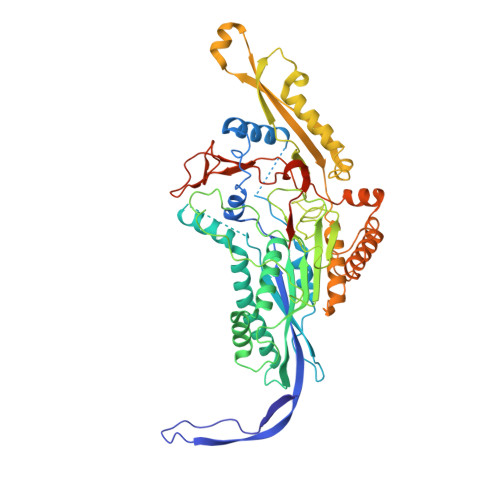Structural basis for loading and inhibition of a bacterial T6SS phospholipase effector by the VgrG spike.
Flaugnatti, N., Rapisarda, C., Rey, M., Beauvois, S.G., Nguyen, V.A., Canaan, S., Durand, E., Chamot-Rooke, J., Cascales, E., Fronzes, R., Journet, L.(2020) EMBO J 39: e104129-e104129
- PubMed: 32350888
- DOI: https://doi.org/10.15252/embj.2019104129
- Primary Citation of Related Structures:
6SJL, 6SK0, 6SKI - PubMed Abstract:
The bacterial type VI secretion system (T6SS) is a macromolecular machine that injects effectors into prokaryotic and eukaryotic cells. The mode of action of the T6SS is similar to contractile phages: the contraction of a sheath structure pushes a tube topped by a spike into target cells. Effectors are loaded onto the spike or confined into the tube. In enteroaggregative Escherichia coli, the Tle1 phospholipase binds the C-terminal extension of the VgrG trimeric spike. Here, we purify the VgrG-Tle1 complex and show that a VgrG trimer binds three Tle1 monomers and inhibits their activity. Using covalent cross-linking coupled to high-resolution mass spectrometry, we provide information on the sites of contact and further identify the requirement for a Tle1 N-terminal secretion sequence in complex formation. Finally, we report the 2.6-Å-resolution cryo-electron microscopy tri-dimensional structure of the (VgrG) 3 -(Tle1) 3 complex revealing how the effector binds its cargo, and how VgrG inhibits Tle1 phospholipase activity. The inhibition of Tle1 phospholipase activity once bound to VgrG suggests that Tle1 dissociation from VgrG is required upon delivery.
Organizational Affiliation:
Laboratoire d'Ingénierie des Systèmes Macromoléculaires, Institut de Microbiologie de la Méditerranée, Aix-Marseille Université-CNRS UMR7255, Marseille, France.















